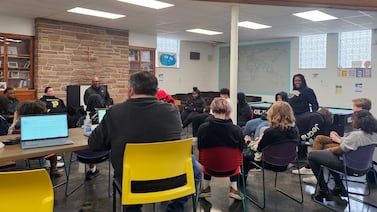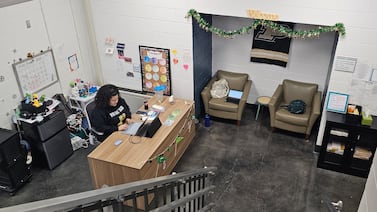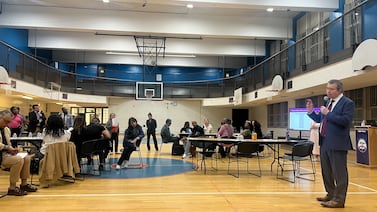New staff, extra training for teachers, and some money going directly to schools.
Those are some of the things some Colorado districts have planned with new state money intended to better serve students who are learning English.
But other districts that also received those funds and that serve tens of thousands of English learners are not planning to add any new services at all.
The state is neither monitoring how districts are deploying the funds nor forcing them to use the money for its intended purpose.
When Colorado lawmakers decided last year to give districts more money to better serve English learners, the idea was that those students require extra services to enable them to access the same level of education as their peers. Legislators acknowledged that poor internet access and language barriers had made it harder for some students to participate in remote learning, and they wanted districts to have resources to help those students in particular.
According to state figures, the state provided approximately $16.8 million in additional money for English learners. Despite good intentions, advocates say the funds are not enough for districts to adequately serve English learners, and some worry that the state didn’t create ways to ensure schools and districts are using the money toward services the students require.
“It is a good step to do more, but then what does it look like when they get it?” asked Cynthia Trinidad-Sheahan, president of the nonprofit advocacy group Colorado Association for Bilingual Education. “How are you going to educate districts, and support them and then hold them accountable? That’s the piece the state forgets to think about.”
Many districts not adding services
Of a dozen districts that responded to Chalkbeat questions about their use of the increased funds, just five described changes to their services.
Most districts said that because they’ve always spent more money on services for English learners than the state has provided, the additional money just helps cover what the district spent in the past. In most cases increased funding still doesn’t cover services for English learners, officials said.
Among those districts are the Denver and Jeffco school districts, the state’s largest. Both said they have not added services with the new funding.
The Denver district, which serves the most English learners, though does not have not the highest proportion, this year received more than $9 million specifically for the approximately 30% of its students who are identified as English learners, up from about $5.9 million in previous years, according to state numbers. But district officials said they allocate approximately $30 million every year to services for English learners.
“The money the district allocates from our general fund in support of our multilingual learners far exceeds the allocation of funding received from the state, even when taking into account the additional funding provided in the current school year,” officials said in a written statement.
Trinidad-Sheahan said that part of the problem is that budgets for departments serving students have remained stagnant for years, even despite districts seeing changing demographics, which may mean different needs, or despite any new funds available.
“Many of those budgets have not increased; they’ve remained the same for years,” she said. “When that money comes in, it’s never looked at as additional funds.”
Adding new programs
Districts that have used this year’s increased state funding to increase the services they provide also spend more on English learners than what the state provides them for those services. Still, they decided to use state funds to augment those services.
The school district in Eagle, which has approximately 30% of its students identified as English learners, received almost double what it previously received in state funds for those students. Still, its $864,000 from the state covers less than 29% of its more than $3 million annual spending on English learners.
This school year, the district added staff to grow the district’s dual language program in middle schools, and also paid for new training for program leaders. Eagle schools has been growing its dual language programming since 2012-13 and this year offers it at five of eight elementary schools and all four of its middle schools.
“Districts, ours and others, do what we need to do when we see the needs,” said Melisa Rewold-Thuon, the district’s assistant superintendent. “There’s of course never enough.”
The dual language program serves students who are learning English as a second language, as well as students who come from English-speaking households and want to become bilingual.
“By giving both populations the opportunity to learn language and learn culture, we think it’s bringing our students together,” Rewold-Thuon said.
While not necessarily covered by the new money, the district also hired bilingual teachers from abroad because it can’t find enough qualified staff for its dual language programs. Previously, the district hired about five teachers annually from abroad, but this year is sponsoring 30.
Eagle’s high schools added teachers in English language development. The last year or so has brought a new wave of teenage immigrant students, including unaccompanied minors, arriving with gaps in their education, in part because of the pandemic disruption.
One day, Eagle officials want to develop a program for new immigrant students, but for now, without such a program, Eagle’s English language development teachers take on the role of social workers to guide new immigrant students in adjusting to and finding resources to navigate their new community.
“Our district is very, very dedicated to meeting the needs of all of our students,” Rewold-Thuon said. “Some students, when we look at equity, just need additional support to even be able to meet that basic educational level. That’s why this funding is so important for us.”
Giving schools flexibility
Anita Pizzo, a high school English language development teacher in Aurora, said in the last two weeks her school has had 15 new students who are new to the country. They come from Congo, Afghanistan, Latin America and elsewhere.
Increasingly, as educators in Eagle are seeing, many of those new students in Aurora arrive never having been in a high school, because of pandemic interruptions to schooling. Pizzo said that those students often have learned to rely on Google Translate, and now have to be taught to stop using it, in favor of learning English.
All teachers need more training to be able to re-engage those students, Pizzo said.
As many districts do, Aurora gives each school a budget based on the number of students they have. Right now, Aurora’s formula for its schools doesn’t take into account if students are English learners, though it does consider other at-risk factors. Next school year, each school will get an additional $195 per English learner, and principals will have flexibility to use that money as they see fit.
For some schools, the increased English learner allocation will not amount to much, but for other schools, it could be enough to hire an additional staff person, for instance.
Aurora, one of the districts with the highest proportions of English learners, went from receiving $3.6 million from the state, to now receiving $6.3 million. Chief Financial Officer Brett Johnson said the district has already been spending more than $6.1 million every year for teacher leaders like Pizzo for all schools. The new money from the state, so far, has helped offset what the district was already paying for.
Next school year, the district will divide up $1.2 million for schools to spend as they choose.
Some teachers and advocates say they would like more transparency on how their schools and districts are spending state money and other funds meant to support English learners.
Pizzo says she has other ideas of support students need, such as curriculum or paraprofessionals to support students when they’re in their English-only classes. Other teachers also say they would like to see more training, tutoring, or more specialists who can help teachers adjust their lessons for students learning English in their classrooms.
Trinidad-Sheahan said that one idea for holding districts accountable would be to ask them how the funds they spend directly support students in each level of English proficiency. She said the newest students, such as newcomers, or those who test in the lowest levels of English proficiency, need the most support.
But sometimes, she said, she has seen districts prioritize spending on programming or materials that will support a larger number of students, such as curriculum for a literacy class that may have a couple of English learners who are more advanced in their journey to being bilingual — even if newcomer students can’t even enroll in that class until they’ve become more proficient in English.
“Can districts actually prove they’re benefiting each level of language learners? That would be difficult for them to prove,” Trinidad-Sheahan said. “These funds should be in addition to. Kids should be getting more.”
Look up how much your district received, below:
Yesenia Robles is a reporter for Chalkbeat Colorado covering K-12 school districts and multilingual education. Contact Yesenia at yrobles@chalkbeat.org.








